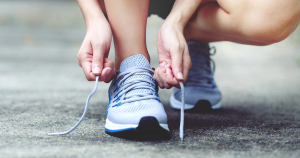If the Shoe Fits! Proper Footwear After Bunion Surgery
 If you’re planning for bunion surgery, your footwear might be top of mind. Aside from your comfort post-surgery, wearing the proper bunion footwear can actually assist with the recovery process. While orthopedic shoes are important, you won’t have to wear them for the rest of your life after bunion surgery. In fact, it may be quite the opposite. Thanks to the latest advances in bunion surgery, you will gradually be able to get back to your favorite and fashionable footwear.
If you’re planning for bunion surgery, your footwear might be top of mind. Aside from your comfort post-surgery, wearing the proper bunion footwear can actually assist with the recovery process. While orthopedic shoes are important, you won’t have to wear them for the rest of your life after bunion surgery. In fact, it may be quite the opposite. Thanks to the latest advances in bunion surgery, you will gradually be able to get back to your favorite and fashionable footwear.
Dr. Robby Amiot, DPM, an orthopedic surgeon at Orthopaedic Hospital of Wisconsin, describes bunion surgery, the recovery process, and the importance of wearing proper footwear after surgery.
Bunion Surgery Recovery Footwear
 Bunion surgery, or a bunionectomy, encompasses a spectrum of procedures that correct the deformity of the first metatarsal and realign the big toe. Your surgeon will decide the best procedure that will provide life-lasting results.
Bunion surgery, or a bunionectomy, encompasses a spectrum of procedures that correct the deformity of the first metatarsal and realign the big toe. Your surgeon will decide the best procedure that will provide life-lasting results.
Minimally Invasive Bunion Surgery Reduces Recovery Time
After the surgery is performed, patients go home immediately and will typically wear a CAM walker (boot) or surgical shoe. Bunion surgery recovery takes 6 to 12 weeks on average. New advanced technology in Minimally Invasive (MIS) Bunion surgery dramatically shortens the recovery.
“It’s very gratifying to see the higher patient satisfaction with MIS Bunion surgery. Several of my patients recovered without needing any pain pills and transitioned to a running-style shoe around 6 weeks,” Dr. Amiot said. “This is much faster than a traditional open bunion surgery procedure.”
Depending on your surgery type, you may be able to put all or part of your weight on your foot after the surgery. This will typically be the course of treatment for 3 to 6 weeks. Many of Dr. Amioits patient’s transition from a CAM walker boot to a surgical shoe around 4 to 6 weeks after surgery. These patients will typically transition to a regular shoe at around 6 to 10 weeks after surgery depending on the type of surgery.
“My MIS Bunion surgery patients typically transition to a regular shoe at 6 to 8 weeks after surgery which is faster than a traditional open procedure,” Dr. Amiot said.
Proper Footwear for Healing a Bunionectomy
Once your surgeon has determined you have healed, you may transition to a shoe and begin working with a physical therapist. Physical therapy will help you return to normal activities faster by working on a range of motion exercises, strengthening, stretching, and gait training. Your therapist will play a vital part in the recovery process by helping you optimize your recovery from surgery. Once you have been permitted by your surgeon to gradually transition to a regular shoe, choosing the correct shoe is very important.
Shoe Style
First, the style of shoe recommended is a running or walking shoe with good traction to avoid slipping on smooth surfaces. These shoes typically have a wider toe box and are more breathable than a casual shoe style. The shoe should provide support and have a typical insole. You want to avoid memory foam shoes as they lack arch support and don’t provide proper cushioning and shock absorption. As you walk with a memory foam shoe, the memory foam gets compressed during the stance phase of gait (when the foot is down on the ground). The memory foam does not fully rebound during the swing phase of gait (foot in the air), leading to less shock absorption and cushioning.
Shoe Fit
The proper shoe fit is very important, and you can easily measure your size at most shoe stores. In general, the shoe should have plenty of width in the front of the foot. When standing in the shoes, your foot should not feel “squeezed”, and it is best to have one centimeter of room from the longest toe to the end of the shoe. With post-operative swelling, your current running shoe may be too tight. To help with swelling and to be able to fit in your pre-operative shoes, you can wear compression socks and loosen your shoelaces. If this is not enough room, you will need to purchase a new larger shoe for the operative foot to accommodate the post-operative swelling and wear double socks on the other foot. Swelling tends to resolve at 3 to 6 months after the surgery.
Once the patient progresses with a running-style shoe and the swelling is almost resolved, they can gradually transition to wearing all their previous shoe gear. This could be 3 to 6 months depending on the procedure and recovery times. The exact surgical techniques, recovery times, and return to your prior footwear are tailored to each patient and should be discussed with your orthopedic surgeon.
If you’re dealing with bunion pain, don’t hesitate to make an appointment with one of our talented orthopedic specialists. The professionals at the Orthopaedic Hospital of Wisconsin are here to help you discuss your treatment options from finding the right orthotic devices and physical therapy exercises, to helping you start the process of bunion surgery.







